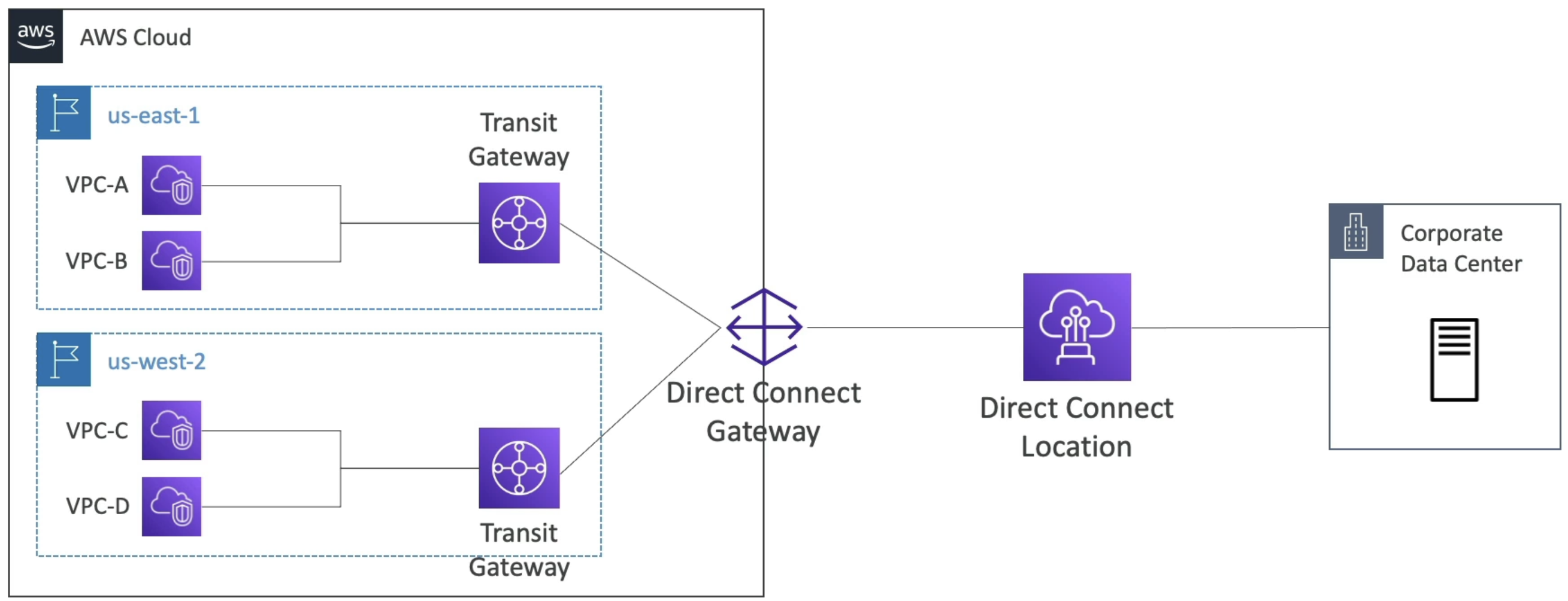VPC
VPC
Virtual Private Clouds are about how we can deploy VM's, storage, and other resources into:
- "virtual" meaning not physical but logically separated
- "private" meaning we don't share things in this logically separated unit
- "cloud" which is just us using someone elses VM's
So a VPC is a way for us to logically separate a group of VM's, typically by IP addresses
TLDR for all of this - Use a Transit Gateway as it's the best hub-and-spoke setup, if it doesn't work good luck
Basics
- CIDR is a block of IP addresses denoted by
X.X.X.X/sizewhereX'sdenote addresses- They have 32 bits in total, or 4 slices of 1 byte
192.168.0.0/24means the first 24 bits of the address are used to designate the network "slice" and the remaining 8 bites are used by any host inside of it- Whatever amount of remaining bits are leftover denotes the size
- means we have 256 IP addresses to use in this network
- Private IP are IP's only avaialble inside of a private network
- These are the only IP's able to be used as private IP's, and any other IP is public
- Technically most people's IP in their homes if they want to have 2 computers talk on local network will be
192.168.X.Xbecause they're private - If you wanted to have 2 computers talk over 2 different local networks they'd need to be relayed / have their own public IP's
- Technically most people's IP in their homes if they want to have 2 computers talk on local network will be
10.0.0.0 - 10.255.255.255which represents10.0.0.0/8is used for big corporate networks172.16.0.0 - 172.31.255.255192.168.0.0 - 192.168.255.255are used for personal local networks
- These are the only IP's able to be used as private IP's, and any other IP is public
- Defintion of VPC
- Must have a defined list of CIDR blocks that cannot be changed afterwards
- Each CIDR within a VPC has minimum
/28and max/16 - VPC is private so only private IP CIDR ranges are allowed
- Subnets are logical separations of your VPC based on CIDR blocks
- Subnets are sub-networks (subsets of networks)
- Instances in subnets are defined by CIDR block of subnet
- First 4, and last 1, IP in subnet are reserved by AWS for networking purposes
- Route Tables
- Used to control where network traffic is directed to
- Can be associated with specific subnets
- The most specific routing rule is always followed
- Internet Gateway (IGW) allow our VPC to connect to the internet
- HA, scales, yada yada
- Acts as a NAT for instances that have a public IPv4 or IPv6 IP address
- Any instance that have traffic routed to the IGW (via route tables) will have internet access, any instances that do not will not!
- Public Subnets have a route table that sends
0.0.0.0/0traffic to IGW- This is the "most broad rule", so if nothing "more specific" is defined in the route table then all instances are public and internet enabled
- If route table has more specific rules, then some of the VM's may not be internet enabled
- Elastic IP (EIP)
- An AWS resources in it of itself
- Allows for static IP addresses that can be associated with EC2 instances
- Typically used for instances that need a fixed public IP
- If you launch an instance in a public subnet, you can just auto-assign it an IP address but it will not be fixed / static
- NAT Instance
- EC2 instance you deploy in a public subnet
- Edit route in private subnet to route
0.0.0.0/0to NAT instance - Not resilient to failure, it's a single EC2
- Must disable Source/Destination check (EC2) setting
- NAT instance should get elastic IP so public internet knows who it's talking to / allow whitelist
- NAT Gateway
- Managed solution with scalable throughput
- Bandwidth scales automatically
- Must dpeploy multiple NAT for multiple AZ for HA
- Has an elastic IP, external services see IP of NAT GW if a private instance utilizes it
- Internet access
- Instances must have IPv4 IP to talk to internet
- Or in a Private (non-public) Subnet instances can access internet with a NAT instance or NAT Gateway setup in a Public Subnet
- Must edit routes so that
0.0.0.0/0routes traffic to NAT
- Must edit routes so that
- Network ACL (NACL)
- Stateless firewall defined at subnet level, applies to all instances within
- Support for allow and deny rules
- Stateless
- Return traffic must be explicitly allowed by rules
- Helpful to quickly and cheaply block specific IP addresses
- Dynamic Host Configuration Protocol (DHCP)
- Automatically assigns IP addresses to instances in a VPC
- Centralized IP configuration or IP protocol, instead of manually doing it ourselves
- DHCP options set can be configured for VPC
- VPC's are associated with DHCP option sets
- DHCP option sets are a collection of settings that can be applied to instances in a VPC
- Options:
- Domain name (suffix in DNS lookup)
- Domain name servers describe what actual servers we'll be using for DNS - typically this stays to the default of AmazonProvidedDNS
- NTP servers for keeping time in sync on instances
- Can't alter a DHCP option set after it's been created, need to create new one and associate it with the VPC
- Why would anyone do this?
- IP address suffixes and DNS servers allow us to route traffic / identify instances that are apart of different services
- Security Groups
- Applied at instance level
- Stateful
- Return traffic automatically allowed regardless of rules
- Can reference other security groups in the same region
- VPC Flow Logs
- Log internet traffic going through VPC
- 3 levels
- VPC level
- Subnet level
- ENI level
- Very helpful to capture "denied internet traffic" to figure out why networking isn't working
- Can be sent to CloudWatch Logs and S3
- Bastion hosts
- SSH into private EC2instance through a public EC2
- You manage these yourselves
- Avoid these, just use SSM
- IPv6
- All are public
- 4.3 billion
- Apparently, there's "so many" that they can't be scanned online, so they appear as pseudo-random
- VPC supports IPv6
- Public subnet
- Create instance w/ IPv6 support
- Route table entry
::/0(IPv6 all) to IGW
- Private subnet
- Instances cannot be reached by IPv6, but they can reach IPv6 instances / addresses
- Create an egress only IGW in VPC
- Add route entry for private subnet from
::/0(IPv6 all) to Egress only IGW
- Public subnet
VPC Peering
- Connect 2 VPC's privately using AWS backbone network
- Can be across regions, across accounts, etc
- Entire goal is to allow services to communicate via private IP addresses
- Make them behave as if they were the same network
- Must not have overlapping CIDR
- Not transitive
- Must create peer between
- Must update route tables in each VPC subnet to ensure instances can communicate
- Once and have setup peering, the route table for A needs to include a route to B's CIDR block and the method for getting there would be the peering connection
- routing table:
- Destination: CIDR
- Target: Peering connection
- VPC Peering can work inter-region and cross-account
- Can reference security group of a peered VPC (cross-account)
- Longest prefix match
- VPC uses longest prefix match to select most specific route
- If we have 2 VPC's with similar CIDR that we peer to frmo a central VPC, we have to use specific route table rules to ensure we send traffic to specific instances
- In the below example we want to send some traffic to a specific instance in VPC B, and the rest to VPC C
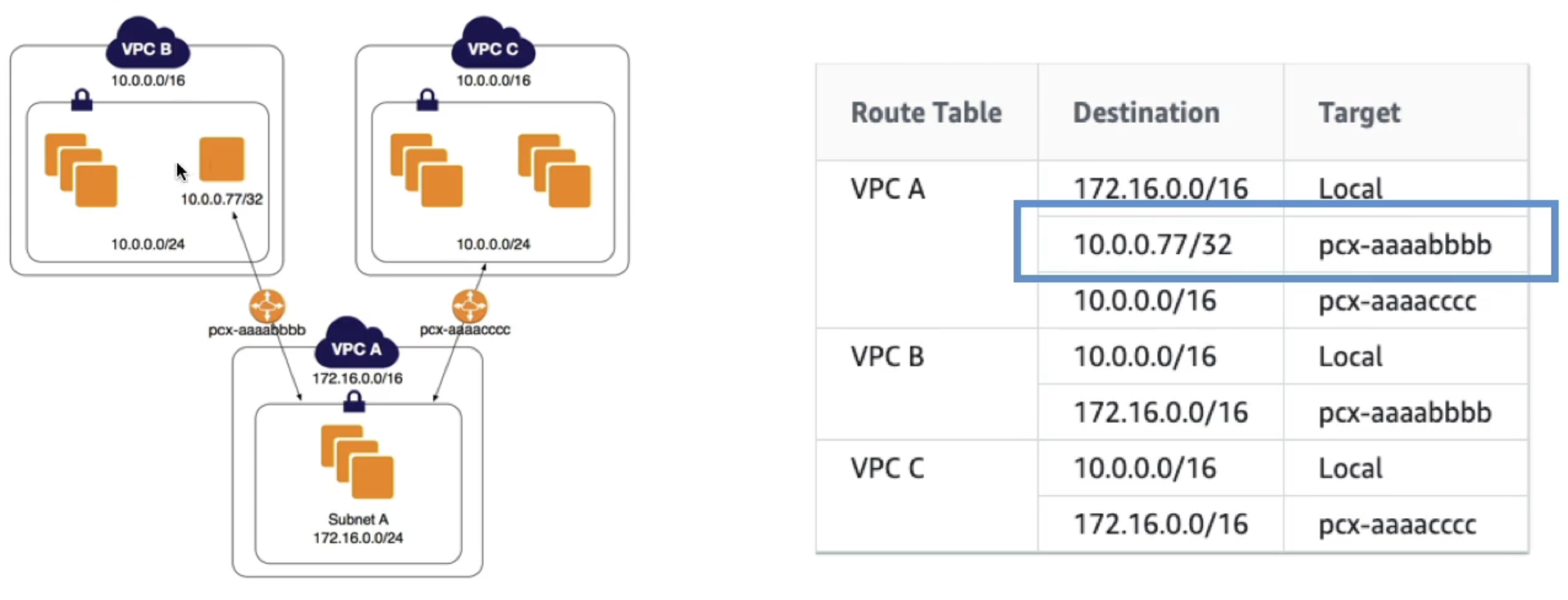
- Invalid configurations
- Overlapping CIDR (even just one!)
- No transitive VPC peering
- No edge to edge routing (same as transitive VPC peering)
- Specifc to VPN, Direct Connect, IGW, NAT GW, VPC Endpoints (S3 and Dynamo)
- These services also don't allow transitive routing based on peering
- This means if we have private VPCs, let's say 5, and then one central VPC with a NAT Gateway and an IGW
- If the NGW is peered to the IGW, and our private subnets are peered each to the NGW, that doesn't mean we can access the IGW from the instances
- This is definition of "edge to edge routing" and it's not allowed, we'd need to connect each instance to IGW itself
- Side note - typical
ping <IP>ICMP protocols don't work over VPC peering connections- This is because security groups and network ACL's block this by default, you can set it up to work
- To test out connectivity, use TCP-based tools like
telnetornc(netcat)
Transit Gateway
- Everything above becomes complicated, there are directed relationships and edge-to-edge considerations
- Transit Gateways are Transitive
- Transit Gateways help to solve this!
- They allow for transitive peering between thousands of VPCs, on-premise networks, and 3rd party networks
- Most of the extra connections are done via AWS Direct Connect and VPN Connection resources
- Transit Gateways allow for hub-and-spoke (star) connection model
- They allow for transitive peering between thousands of VPCs, on-premise networks, and 3rd party networks
- Regional resource
- Can peer Transit Gateways themselves across regions
- One TGW in each region, and then peer all of those together
- Attach each resource to a TGW via TGW Attachment
- Similar to VPC Peering, you must update route tables:
- Destination: Some other Subnet CIDR
- Target: TGW Attachment
- Because of having to update route tables, there's still a ton of work on updating each connected resource in the network mesh, but we do not have to manually accept and deny each of the peering requests anymore
- It's still much smaller than peering all of them
- If there are VPC's, then we would need peering connections (fully completed graph), versus just connecting each of the , once, to the TGW
- We would still need to update all route tables, but this is typically more scalable and easier to accomplish
- Share cross account via Resource Access Manager (RAM)
- Route tables allow us to limit which VPC's can talk to each other
- Works with Direct Connect, VPN Connections
- Supports IP Multicast (which is not supported by any other AWS Service)
- Allows instances in any VPC to access following resources in other VPC's that are attached to TGW:
- NAT GW
- NLB
- PrivateLink
- EFS
- More
- Using a Transit Gateway allows us to alleviate the problem in VPC Peering where we couldn't have a central NAT GW!
- Below we can see our Egress-VPC has all of the required NAT GW and IGW setup with correct routing tables
- Shows how Egress-VPC routes any traffic from
10.0.0.0/16back to TGW-Internet to route to App-VPC's - And then how App-VPC's route traffic to TGW-Internet, and any route not back to
10.0.0.0/16gets routed out to IGW out to the internet- Q: TGW-Internet is actually being routed to ENI's, which then route to NAT GW, and this is because:
- That's just the way things work
- For TGW to attach to VPC's it needs some sort of entry/exit point, and that is the sole purpose of ENI's
- The NAT GW itself is implemented as an ENI in a public subnet
- Therefore, traffic from TGW-Internet is routed to ENI of NAT GW which then performs NAT before forwarding traffic to IGW
- Q: Also NAT GW need to come before IGW because:
- Private instances cannot route directly to an IGW - they have to go through NAT GW which translates private IP to public
- IGW only allows outbound traffic from public IP's...the NAT GW provides that public IP
- If we bypass NAT GW the private instances wouldn't have valid public IP's for internet access
- Q: TGW-Internet is actually being routed to ENI's, which then route to NAT GW, and this is because:
- Shows how Egress-VPC routes any traffic from
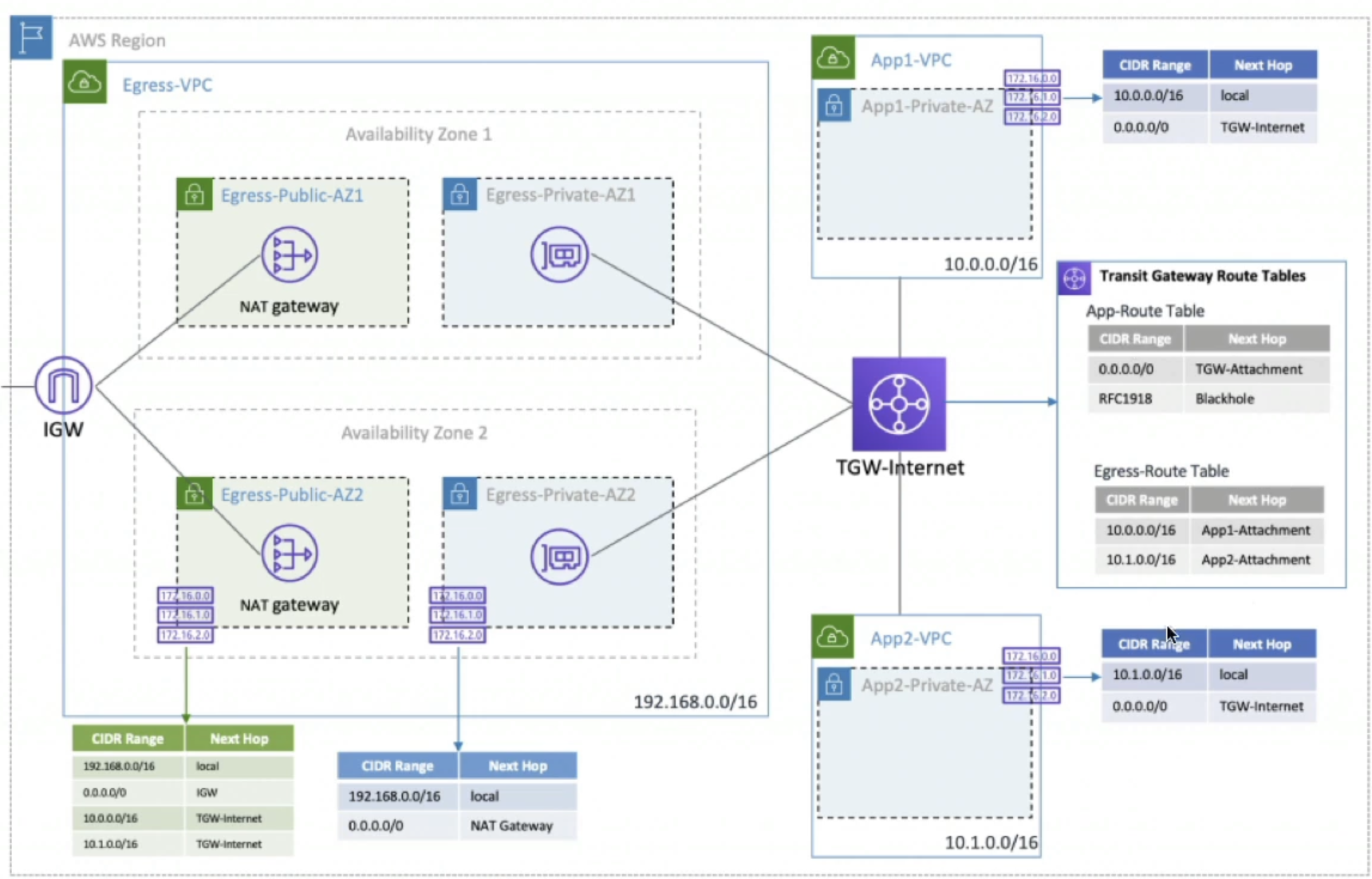
- Below we can see our Egress-VPC has all of the required NAT GW and IGW setup with correct routing tables
- Can use AWS RAM to share a TGW for VPC attachments across accounts or Organizations
- Allows the Share, Accept, Use flow to happen a lot faster
- Use different routing tables to prevent VPC's from communicating that you don't want
- Allows us to do Direct Connect to corporate data centers from multiple regions
- Intra and Inter region peering
- Allows for data mesh architecture where we can have a Hub TGW per region that connects multiple resources and accounts in that region, and then for every region we have we connect the Hub TGW's to create a mesh of TGW's across all regions
VPC Endpoints
- Allows us to connect to AWS Services using a private network instead of public www network
- Scale horizontally and are redundant
- No more need for NAT GW --> IGW --> Back to whitelisted service to access our other public services
- VPC Endpoint GW used for S3 and DynamoDB to access these resources using AWS backbone without going over internet
- Must update route table entries
- Destination needs to have target of
vpce-ID- S3 destinations have a specific IP that will show up when we try to enter it in route table...can come from name, but you'll see it
- This is public hostname, use this not public IP
- Allows full private access from EC2 to S3
- DNS Resolution must be enabled
- GW endpoint can't be extended outside of VPC via peering
- Same for Dynamo
- S3 destinations have a specific IP that will show up when we try to enter it in route table...can come from name, but you'll see it
- Destination needs to have target of
- Gateway defined at VPC level
- Must update route table entries
- VPC Endpoint Interface used for all other services to access without going over internet
- Endpoint Interfaces are ENI's so it must live in a subnet
- This ENI has some private hostname
- We leverage security groups for security
- To reach this we need Private DNS
- Public hostname of service will resolve to private endpoint interface hostname
- DNS Hostnames and DNS Support must be enabled
- Interfaces shareable across Direct Connect or Site-To-Site VPN
- In case of issues using these we can check DNS Settings resolution or route tables to figure out why routing isn't working
- Endpoint Interfaces are ENI's so it must live in a subnet
VPC Endpoint Policies
- JSON documents, similar to IAM policies, that allow us to configure authorization
- Applied at VPC Endpoint level
- These documents do not override or replace IAM user policies, or service policies
- Someone could circumvent this and go directly to the resource, but these policies allow us to filter actions on final resources through VPC Endpoint
- We'd have to update final resource policy (S3, Dynamo, etc) to disallow any actions not from VPCE
- Conditions like
aws:sourceVpce: IDcan disallow anything not from that VPCE- This only works for VPCEndpoints and private traffic
- S3 policies can only restrict access from public IP's
PrivateLink
- AKA / FKA AWS VPC Endpoint Services
- Most secure way to expose a service to 1000's of VPC's (across multiple or one account)
- Doesn't require VPC peering, IGW, NAT GW, route tables, etc
- Requires a NLB in service VPC and ENI in Customer VPC
- AWS Private Link then establishes a private link b/t ENI and NLB
- Client talks to ENI, ENI forwards to NLB, NLB talks to service applications
- This ensures thousands of VPC's (thousands of ENI's) can talk to 1 single NLB in service VPC
- NLB and ENI's can be made multi-AZ as well to be fault tolerant
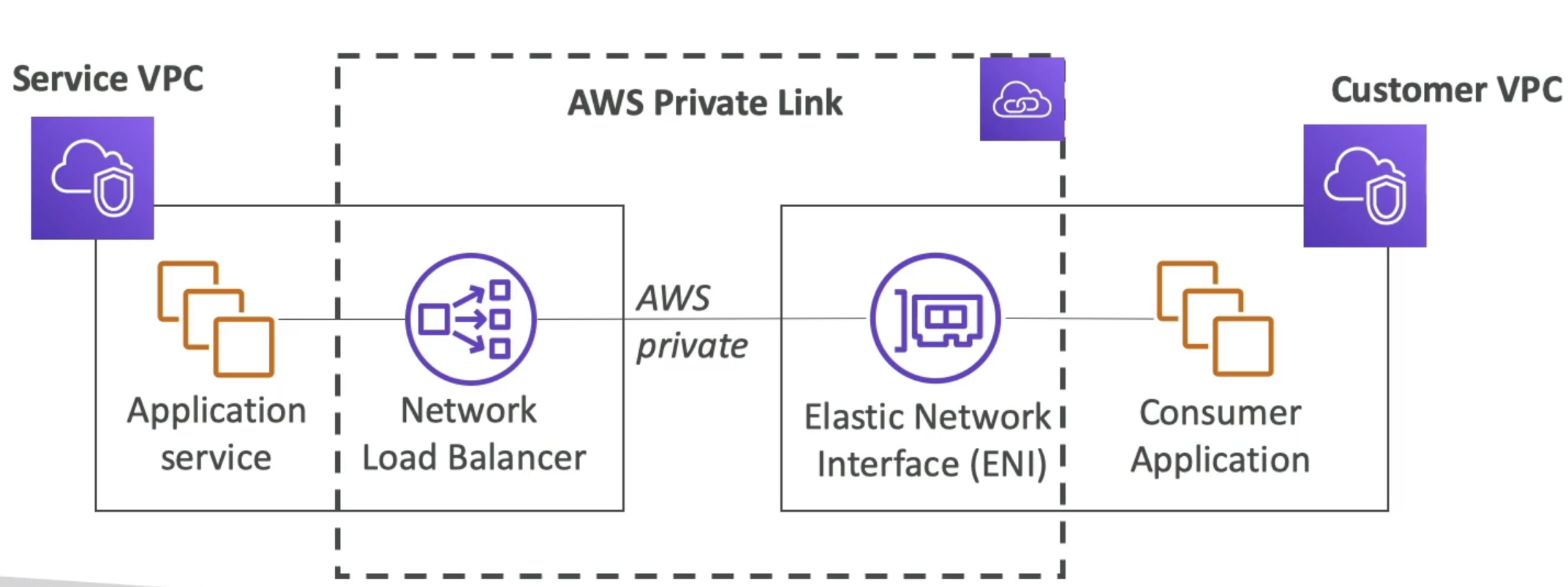
Site to Site VPN (AWS Managed VPN)
- Corporate Data Center and VPC that we want to connect over public internet
- They could connect over private IP with infra above, but let's focus on public
- Setup software or harddware VPN appliance on-prem
- On prem VPN should be accessible using a public IP
- AWS Side we setup a Virtual Private Gateway VGW and attach to VPC
- Setup Customer gateway to point the on prem VPN appliance
- Two VPN conncetions (tunnels) are created for redundancy
- At this point the VGW can talk to the Customer Gateway

Route Propogation
- How can instances communicate to VGW?
- Route table!
- Need to set this up so that if an instance tries to reach Corporate Data Center, it gets routed via VGW, and vice versa
- Static routing is easy - you just write all of the IP's in via CIDR
- Any changes must be manually updated
- Dynamic routing is tougher
- Border Gateway Protocol (BGP) allows us to share routes (route table) automatically (eBGP for internet)
- We don't update route table, it's done for us automatically
- Just need to specify Autonomous System Number (ASN) for CGW and VGW
- ASN's are defined and show on each of the 2 gateways, so they're easy to find
- Then we just specify we want dynamic routing and things are updated automatically
- Site To Site VPN and Internet Access
- At this point we now have a public subnet with NAT GW and IGW in AWS VPC
- Can we provide internet access to corporate data center via IGW?
- No!
- What if we use a NAT Instance instead?
- For some f'ing reason yes!
- "Because we manage the software on NAT instance we can"
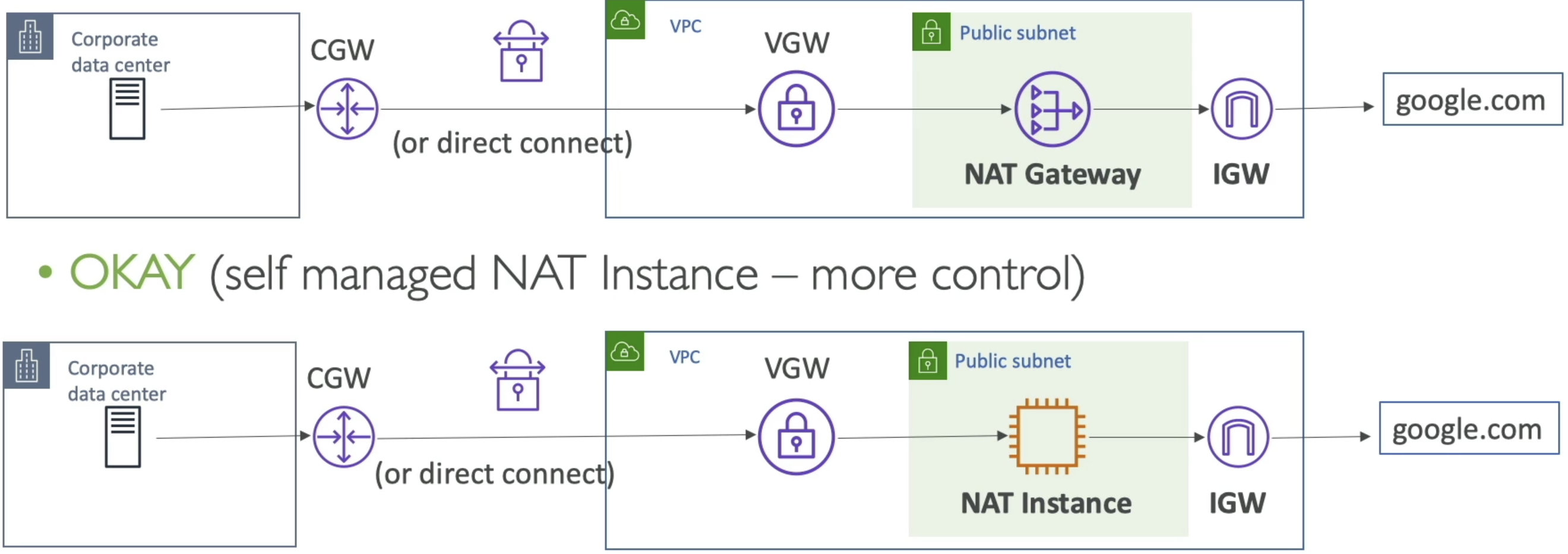
- Another valid solution is to flip things around and have an on-premise NAT in corporate data center, and have private instances in VPC get to internet there
- TLDR; If you own NAT software on EC2 instance or on-premise, you can do this
VPN CloudHub
- Allows us to connect up to 10 customer gateways for each VGW
- Essentially allows AWS to be a central hub for up to 10 customers on premise networks via VPN
- These customers would all be able to talk to each other as well
- Low cost hub-and-spoke model
- Provides secure communication between sites and uses IPSec for secure communication
- If there are multiple VPC's on AWS, and one single on-premise corporate network with a Customer Gateway, AWS recommends making one VPN connection from each VPC to CGW
- Another option here is to use Direct Connect Gateway, but that comes later
- Another option is a Shared Services VPC
- Site-To-Site VPN and then replicate services, or deploy a fleet of proxies on VPC, so that any number of VPC's in AWS account can just peer to the Shared Services VPC
- Transit Gateway hub-and-spoke model so that we don't have to establish all of these VPN's to our corporate data center
AWS Client VPN
- Connect from personal computer using OpenVPN to private network on AWS and on-prem
- Can connect to EC2's using private IP
- Allows us to setup multiple peering architectures:
- AWS S2S VPN or VPC Peering from AWS to Corporate data center
- Setup ENI in private subnet on AWS
- Enable Client VPN to connect to Client VPN ENI
- This would allow personal computers to access corporate data center and AWS VPC in a private connection
- Internet Access
- Since IGW require public IP addresses we could also setup an ENI in a public subnet
- Connect to ENI via AWS Client VPN from personal computer
- At that point we'd be able to reach the internet via ENI and resources in VPC
- If we have Private Subnets as well, then we'd need NAT GW in Public subnets and ENI in private subnets
- ENI provides entry/exit point in private subnets (as we described in TGW) which is routed to NAT GW
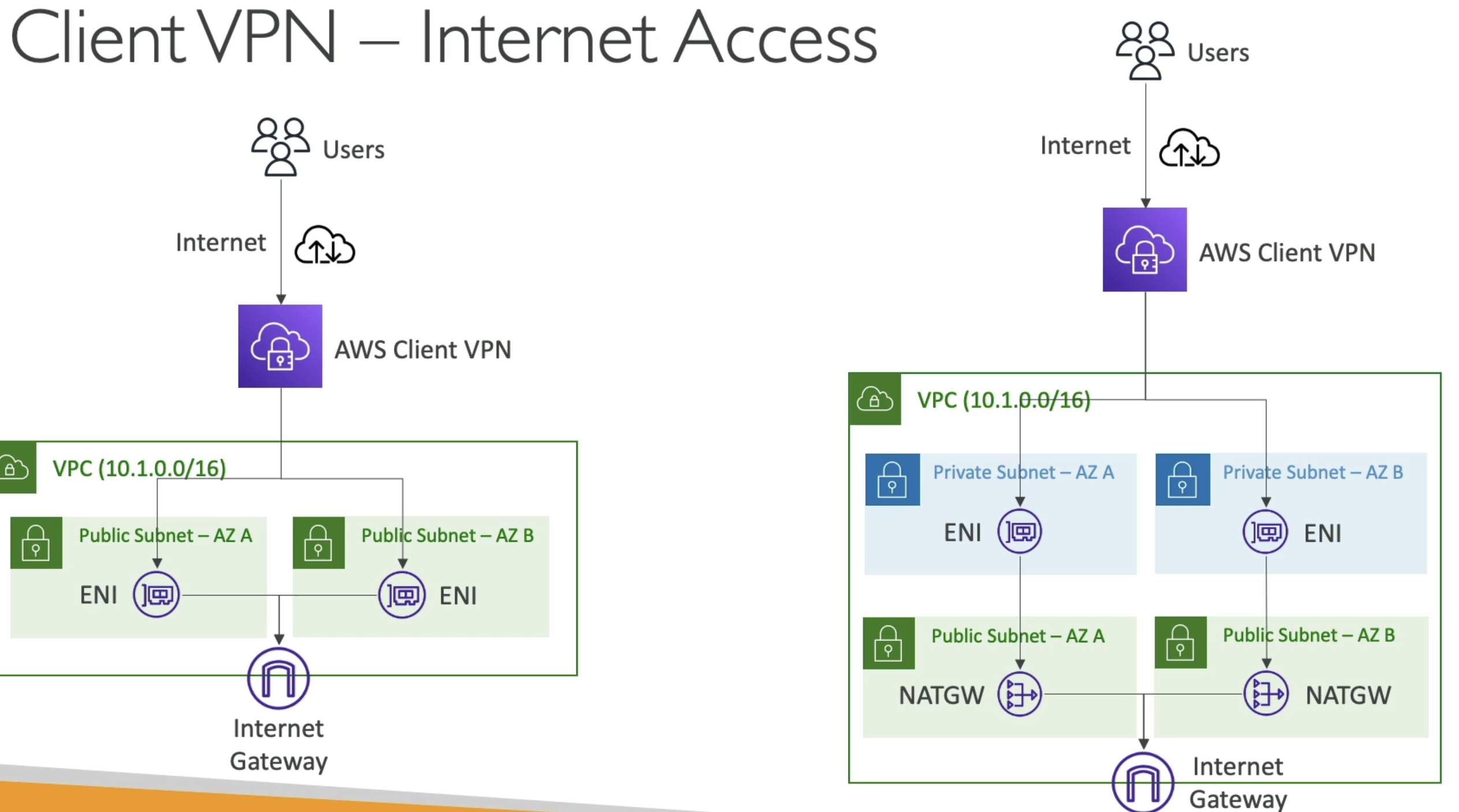
- What if we had a Transit GW?
- Thena ll of this is possible, and we can setup
- Central hub TGW with ENI
- ENI in private subnets somewhere
- Connect AWS Client VPN to ENI
- Reach any VPC from ENI + TGW
- Thena ll of this is possible, and we can setup
AWS Direct Connect
- Provides a dedicated private connection from remote network to VPC
- Completely bypasses ISP
- Virtual Interfaces (VIF):
- Public VIF allows us to connect to public AWS endpoints (S3, EC2 services, anything AWS)
- Private VIF conncets to resources in private VPC (EC2, ALB, S3, etc)
- VPC Interface Endpoint can be access through private VIF
- Transit VIF connect to resources in a VPC using a TGW
- Setup as AWS Direct Connect locations with customer cage + AWS Direct connect cage
- Virtual GW on AWS conncets to AWS DC Cage and through to customer router or firewall on corporate data center

- Connection Types:
- Dedicated connections
- 1 GB/s, 10 GB/s, 100 GB / s capactity with physical ethernet port dedicated to customer
- Takes ~ a month to setup between client and AWS
- Hosted connections
- Capacity added or removed on demand
- 1, 2, 5, 10 GB/s avaialble
- Mostly 50 MB/s, 500 MB / s, up to 10 GB / s
- Dedicated connections
- Encryption
- Data in transit is not encrypted, but it's private
- Direct connect + VPN provides IP Sec encrypted private connection
- VPN over direct connect uses public VIF
- Link Aggregation Groups (LAG)
- Get increassed speed and failover by summing up existing DX connections into a logical one
- Aggregate up to 4 cnxns in active-active mode
Direct Connect Gateway
- If you want to setup a Direct Connect to one or more VPC in many different regions
- Can use a Direct Connect Gateway to remove redundant connections and centralize hub-and-spoke
- We can also connect Direct Connect gateway as another spoke on TGW
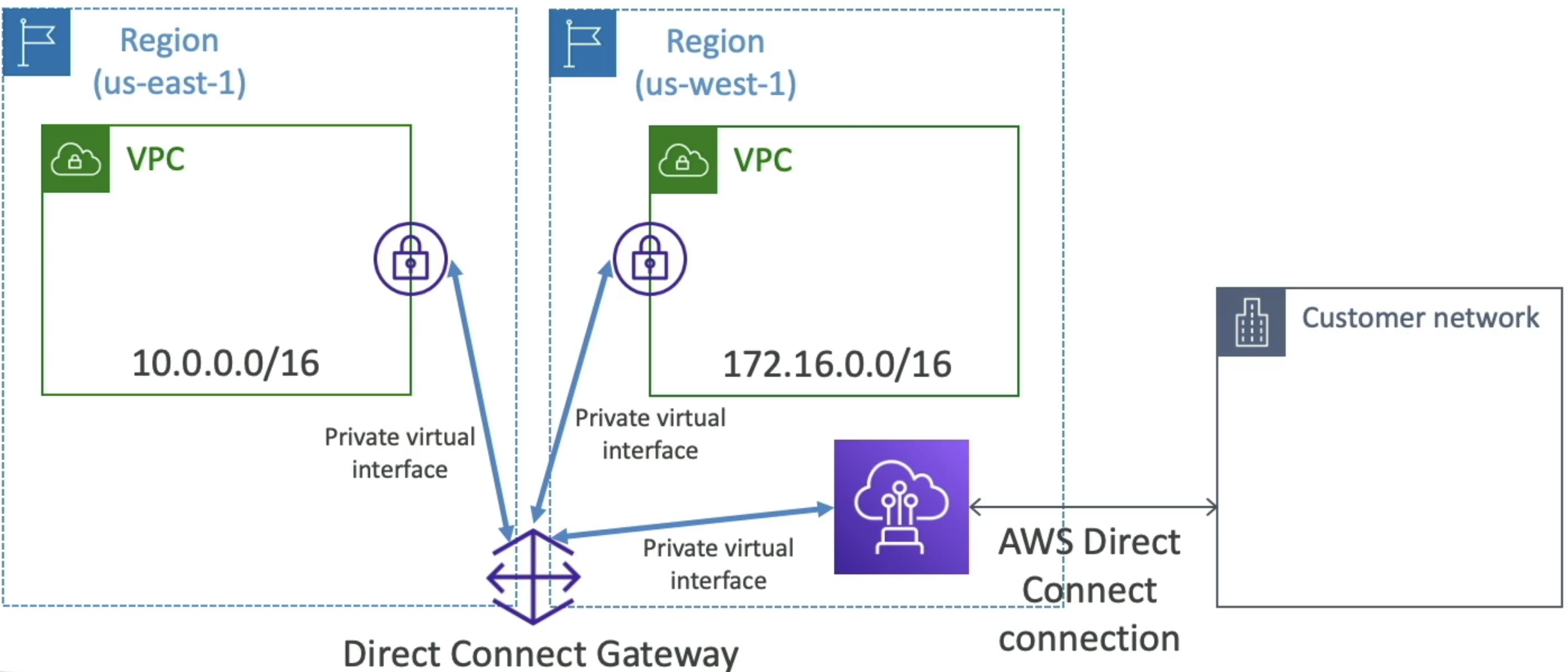
VPC Flow Logs
- VPC level, subnet level, or ENI level flow logs
- Help for troubleshooting
- S3, CW Logs, Kinesis Data Firehose
- Specific format of source, dest, bytes, etc...
- Query using Athena on S3 or CW Logs Insights
AWS Network Firewall
- Protecting networks
- Network Access Control Lists
- Security Groups
- WAF (malicious requests)
- AWS Shield
- AWS Firewall Manager (mgmt across accounts)
- How can we protect VPC in a sophisticated way?
- AWS Network Firewall
- Protect enitire VPC from OSI Layer 3 - 7
- Can inspect from any direction:
- VPC to VPC
- Outbound to internet
- Inbound from internet
- To / From Direct Connect and S2S VPN
- Internally the AWS Network Firewall uses AWS Gateway Load Balancer
- Can be managed across accounts
- Supports 1,000's ofrules
- IP & Port
- Protocol
- Regex pattern matching
- etc
- Common architectures
- Inspection VPC + Egress VPC
- Allows for us to track all requests, give internet access, and allow for on-prem and VPC
- TGW sitting in center
- Everything goes to Inspection VPC via TGW, and back to TGW, and then any internet traffic routed to Egress VPC
- Routing is done entirely in TGW, and ensures all traffic sink into Inspect VPC and then back out to TGW
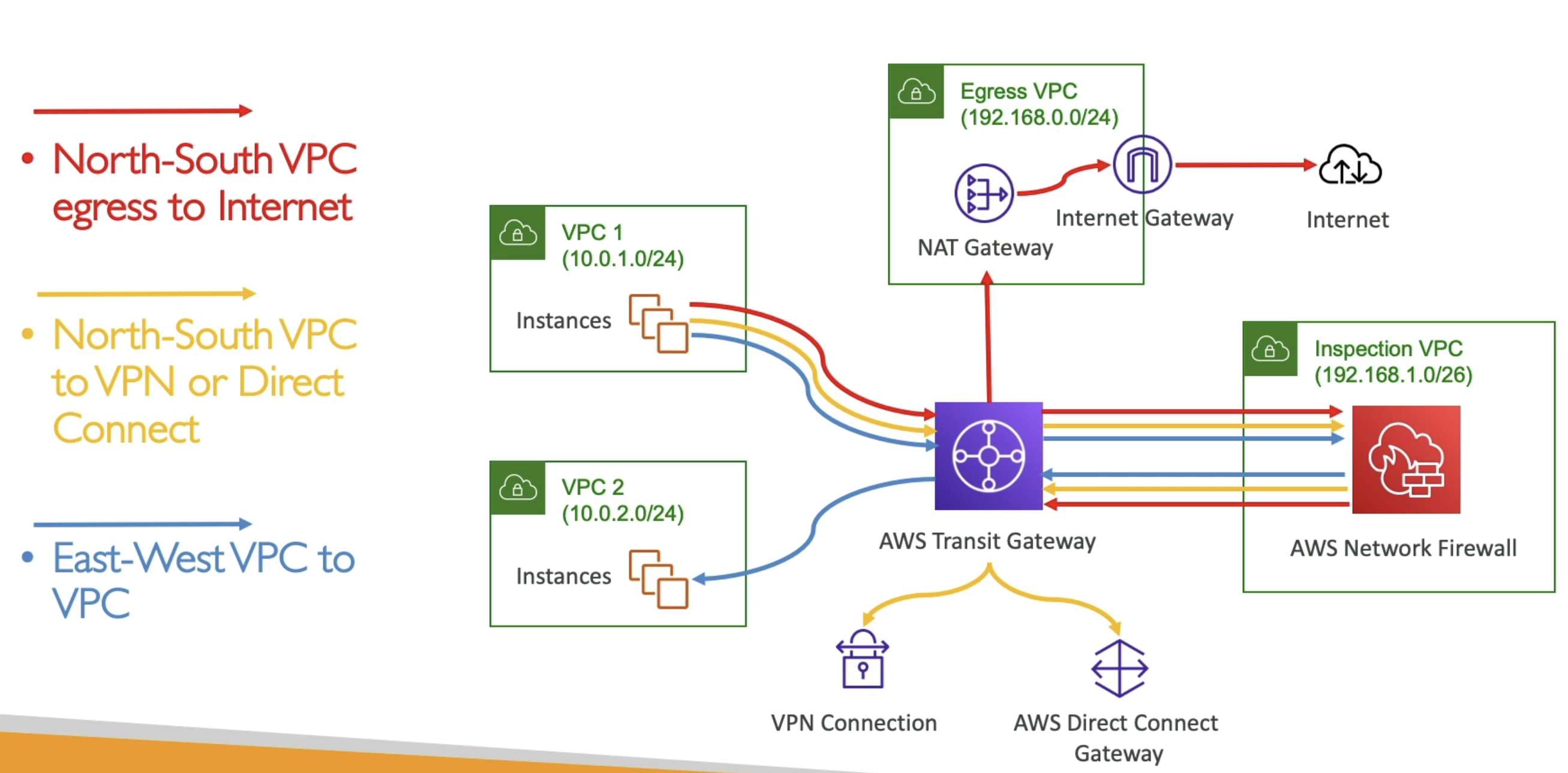
- Inspection VPC + Egress VPC
